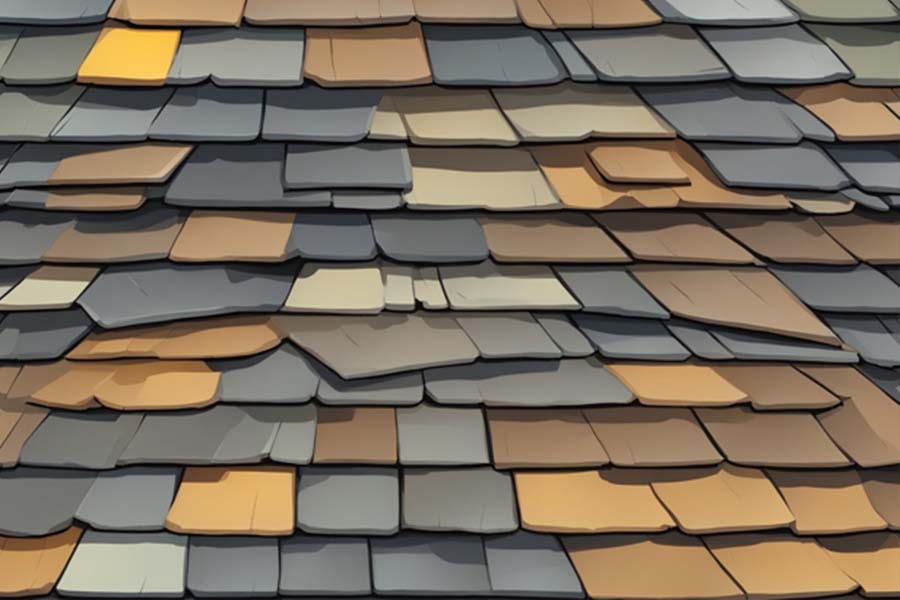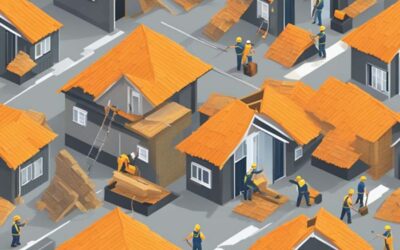Adding new shingles over old ones may seem like a convenient and cost-effective solution for homeowners who need to repair or replace their roof. However, this practice comes with several risks that can lead to serious problems down the line. In this article, we will explore the dangers of adding new shingles over old ones and why it’s important to follow proper roofing procedures.
One of the main risks of adding new shingles over old ones is that it can lead to an uneven surface. This can cause water to pool in certain areas, which can lead to leaks and other water damage. Additionally, the added weight of the new shingles can put extra stress on the roof’s structure, which can lead to sagging or even collapse in extreme cases.
Another risk of adding new shingles over old ones is that it can void your roof’s warranty. Many roofing manufacturers require that old shingles be removed before new ones are installed in order to ensure proper installation and prevent any issues that may arise from having multiple layers of shingles. If you add new shingles over old ones and something goes wrong, you may not be covered by your warranty, which can be a costly mistake.
Understanding Roof Shingle Layers
When it comes to understanding the risks of adding new shingles over old ones, it’s important to have a clear understanding of the layers of a roof. A typical roof consists of multiple layers, each with its own purpose and function.
The first layer of a roof is the decking, which is the base layer that supports the weight of the shingles. The decking is typically made of plywood or OSB (oriented strand board) and is attached to the roof trusses or rafters.
The second layer is the underlayment, which is a water-resistant barrier that is placed directly on top of the decking. The underlayment helps to protect the decking from moisture and prevents water from penetrating the roof.
The third layer is the shingle layer, which is the visible layer that provides protection from the elements. Shingles come in a variety of materials, including asphalt, wood, metal, and slate.
When adding new shingles over old ones, it’s important to consider the condition of the existing shingles and the weight of the additional layer. Adding a second layer of shingles can add significant weight to the roof, which can cause structural issues over time.
In addition, adding new shingles over old ones can also mask underlying issues such as leaks or damage to the decking or underlayment. It’s important to have a professional inspect the roof before adding new shingles to ensure that any underlying issues are addressed before the new shingles are installed.
Overall, understanding the layers of a roof is an important step in evaluating the risks and benefits of adding new shingles over old ones. By taking the time to assess the condition of the existing roof and consulting with a professional, homeowners can make informed decisions about their roofing needs.
Potential Cost Savings and Risks
When considering adding new shingles over old ones, there are potential cost savings to be had. By not removing the old shingles, homeowners can save money on labor costs and disposal fees. Additionally, the new layer of shingles can provide added insulation and protection to the roof.
However, there are also risks associated with adding new shingles over old ones. One major risk is that the added weight of the new layer of shingles can put stress on the roof structure. This can lead to sagging, cracking, or even collapse in extreme cases.
Another risk is that the new layer of shingles may not adhere properly to the old layer, leading to premature failure and the need for costly repairs. Additionally, the added thickness of the shingles can cause problems with flashing and ventilation, which can lead to moisture buildup and damage to the roof and attic.
In summary, while there are potential cost savings to be had by adding new shingles over old ones, homeowners should be aware of the risks involved. It is important to consult with a professional roofer to determine whether this option is appropriate for your specific situation.
Assessment of Existing Shingles
When considering adding new shingles over old ones, it is crucial to assess the condition of the existing shingles. This assessment will help determine if the roof is suitable for the addition of new shingles or if a complete tear-off is necessary.
One of the first things to check is the age of the existing shingles. If the shingles are approaching the end of their lifespan, adding new shingles over them may not be a wise decision. It is also essential to check for any signs of damage, such as cracks, curling, or missing shingles. Any damage to the existing shingles can compromise the integrity of the entire roof system.
Another critical factor to consider is the weight of the existing shingles. Adding new shingles over old ones can add significant weight to the roof, which may exceed the load capacity of the roof structure. This can lead to structural damage and compromise the safety of the building.
It is also important to assess the condition of the roof deck. If there is any rot or damage to the deck, adding new shingles over old ones can exacerbate the problem and lead to further damage.
In summary, assessing the condition of the existing shingles is a crucial step in determining whether adding new shingles over old ones is a viable option. A professional roofing contractor can help assess the condition of the roof and provide recommendations for the best course of action.
Weight Considerations and Structural Integrity
When considering adding new shingles over old ones, weight considerations and structural integrity are important factors to keep in mind. The additional weight of the new shingles can put stress on the underlying structure, which can lead to issues such as sagging or even collapse.
It is important to note that building codes and regulations vary by location, and it is essential to consult with a professional before undertaking any roofing project. A roofing contractor can assess the structural integrity of the roof and determine if adding new shingles over old ones is a viable option.
In general, it is not recommended to add more than one layer of shingles to a roof. Each layer adds weight and can compromise the structural integrity of the roof. Additionally, the added weight can put stress on the roof’s support system, leading to potential issues such as cracking, bending, or even collapse.
It is also important to consider the type of shingles being used. Different types of shingles have varying weights and thicknesses, which can impact the overall weight of the roof. For example, asphalt shingles are lighter than slate or tile shingles and may be a better option for roofs with weight limitations.
Overall, when considering adding new shingles over old ones, it is essential to consult with a professional and ensure that the roof’s structural integrity can support the additional weight. Failure to do so can result in costly repairs or even safety hazards.
Implications for Roof Longevity
Adding new shingles over old ones may seem like a cost-effective and easy solution, but it can have serious implications for the longevity of a roof.
Firstly, the added weight of the new shingles can put extra stress on the roof’s structure, leading to potential damage and even collapse. This is especially true for older roofs that may not be able to handle the additional weight.
Secondly, the new shingles may not adhere properly to the old ones, causing air pockets and moisture buildup. This can lead to rot, mold, and other serious issues that can compromise the structural integrity of the roof.
Furthermore, adding new shingles over old ones can make it difficult to identify and address underlying issues such as leaks or damage to the underlying structure. This can lead to more extensive and expensive repairs down the line.
In summary, while adding new shingles over old ones may seem like a quick fix, it can have serious implications for the longevity and safety of a roof. Homeowners should consider consulting with a professional roofer to determine the best course of action for their specific situation.
Challenges with Inspection and Repairs
Inspecting and repairing a roof with multiple layers of shingles can be a challenging task. It is difficult to determine the condition of the underlying layers, which can hide potential issues such as leaks, rot, or damage.
In addition, repairs to a multi-layered roof can be more complicated and expensive than repairs to a single-layered roof. Roofers may need to remove multiple layers of shingles to access the damaged area, which can increase labor costs and time.
Furthermore, adding new shingles over old ones can make it difficult to properly seal the roof. The additional layers can create gaps and spaces that allow water to penetrate the roof, leading to leaks and water damage.
To ensure the safety and longevity of a roof, it is important to have it inspected by a professional roofing contractor. They can assess the condition of the roof and provide recommendations for repairs or replacement. It is also important to address any issues promptly to prevent further damage and costly repairs in the future.
Overall, the challenges with inspection and repairs of a multi-layered roof highlight the importance of proper installation and maintenance. Homeowners should consider the potential risks and costs before adding new shingles over old ones and consult with a professional roofing contractor for guidance.
Warranty and Insurance Considerations
When considering whether to add new shingles over old ones, it is important to take into account the warranty and insurance implications.
Most shingle manufacturers will not provide a warranty for shingles that are installed over existing ones. This is because the manufacturer cannot guarantee that the old shingles are in good condition and that the new shingles will adhere properly. Therefore, if a problem arises with the roof, the manufacturer may not cover the cost of repairs or replacement.
Additionally, insurance companies may consider the installation of new shingles over old ones to be a form of improper roof repair. If this is the case, the insurance company may not cover the cost of any damage that occurs to the roof or the property as a result of the installation.
It is important to check with both the shingle manufacturer and the insurance company before proceeding with the installation of new shingles over old ones. This will ensure that the homeowner is aware of any potential warranty or insurance issues that may arise.
In summary, adding new shingles over old ones can have warranty and insurance implications that should be carefully considered before proceeding with the installation.
Building Codes and Legal Compliance
Building codes and legal compliance are important considerations when it comes to adding new shingles over old ones. In most areas, building codes dictate the minimum requirements for roofing installations. Failure to comply with these codes can result in fines, legal action, and even the removal of the roof altogether.
One of the primary concerns with adding new shingles over old ones is weight. Building codes typically specify the maximum weight that a roof can support, and adding new shingles can exceed this limit. This is especially true if the old shingles are not removed, as the weight of the new shingles will be added to the existing weight of the old shingles.
Another concern is the condition of the old shingles. Building codes may require that damaged or deteriorated shingles be removed before new ones are installed. This is because the old shingles may not provide adequate support for the new ones, and may also compromise the integrity of the roof.
In addition to building codes, homeowners should also be aware of any legal requirements for roofing installations in their area. This may include obtaining permits, complying with zoning regulations, and following other local laws and ordinances. Failure to comply with these requirements can result in legal action and costly fines.
Overall, it is important to carefully consider building codes and legal compliance when adding new shingles over old ones. By following these requirements, homeowners can ensure the safety and integrity of their roof, and avoid costly legal and financial consequences.
Environmental Impact of Layering Shingles
Layering shingles is not only a risky practice, but it also has a negative impact on the environment. Here are some of the environmental concerns associated with layering shingles:
Increased Waste
Layering shingles means that there are more shingles being used per roofing job. This leads to an increase in waste, as the old shingles are not removed and disposed of properly. This waste can end up in landfills, where it takes up valuable space and can potentially harm the environment.
Increased Energy Use
Layering shingles can also lead to increased energy use. This is because the added weight of the new shingles can cause the roof to retain more heat, which can increase the demand for air conditioning. This increased demand for air conditioning can result in higher energy bills and increased greenhouse gas emissions.
Decreased Lifespan of New Shingles
Layering shingles can also decrease the lifespan of the new shingles. This is because the old shingles can trap moisture, which can lead to mold growth and other issues. This moisture can also cause the new shingles to deteriorate faster, which can lead to the need for more frequent roof repairs and replacements.
In summary, layering shingles can have a negative impact on the environment by increasing waste, energy use, and decreasing the lifespan of new shingles. It is important to properly remove and dispose of old shingles to minimize these environmental concerns.
Best Practices for Shingle Layering
When it comes to layering shingles, there are a few best practices that should be followed to ensure a quality installation. These practices include:
1. Remove Old Shingles
Before installing new shingles, it is important to remove the old ones. This allows for a proper inspection of the roof deck and ensures that any damaged or deteriorated areas are repaired before installing the new shingles. Additionally, removing the old shingles allows for a better bond between the new shingles and the roof deck.
2. Use the Right Materials
When layering shingles, it is important to use the right materials. The new shingles should be the same type, size, and quality as the existing ones. Using different materials can cause issues with the roof’s performance and aesthetics.
3. Follow Manufacturer’s Instructions
Always follow the manufacturer’s instructions when installing shingles. This includes proper placement, nailing patterns, and any other specific instructions for the type of shingle being installed. Failure to follow these instructions can result in a voided warranty or premature failure of the shingles.
4. Limit the Number of Layers
It is recommended to limit the number of shingle layers to two. Adding more layers can add unnecessary weight to the roof and increase the risk of leaks. Additionally, building codes in some areas may limit the number of layers allowed.
By following these best practices, homeowners can ensure a quality shingle installation and avoid potential issues down the road.





0 Comments